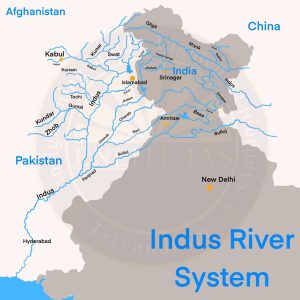Basics
- Other Name: The Indus River is also called the Sindhu.
- Basin Countries: China(Tibet), India and Pakistan.
- Origin: It originates from a glacier near Bokhar Chu in the Tibetan region in the Kailash Mountain range near the Mansarovar Lake.
- Mouth: In Sindh Province, the river accumulates a lot of sediments and forms the Indus River delta before draining into the Arabian Sea near Karachi.
- Major Species: The blind Indus River Dolphin, a sub-species of dolphin, is found only in the Indus River.
- Tributaries are
- Left Bank Tributaries: Zaskar, Suru, Soan, Jhelum, Chenab, Ravi, Beas, Satluj, and Panjnad rivers.
- Right-Bank Tributaries: Shyok, Gilgit, Hunza, Swat, Kunnar, Kurram, Gomal, and Kabul rivers.

Tributaries in Himalayas
- Shyok River
- Rising from the Karakoram Range at Rimo glacier.
- The river widens at the confluence with the Nubra River.
- Nubra River
- It is the main tributary of the Shyok River.
- It originates from the Nubra Glacier.
- Shigar River
- It rises from the Hispar Glacier.
- It joins Indus at Skardu.
- Hunza River
- It is an important left-bank tributary of the Gilgit River.
- It rises from a glacier north of the Karakoram Range in the northwestern part of Jammu and Kashmir.
Tributaries in Plain
- Chenab River
- Origin: The Chenab originates from near the Bara Lacha Pass in the Lahul-Spiti part of the Zaskar Range.
- Formation: Chenab river is formed by the confluence of the Chandra and Bhaga rivers at Tandi located in the upper Himalayas in the Lahul and Spiti District of Himachal Pradesh
- Passing Region: It flows through the Jammu region of Jammu and Kashmir into the plains of Punjab in Pakistan
- Fact
- The waters of the Chenab are allocated to Pakistan under the terms of the Indus Water Treaty
- The river is crossed in Jammu and Kashmir by the world’s highest railway bridge named Chenab Bridge.
- Jhelum River
- Associated River:
- It is a tributary of the Chenab River
- It ends in a confluence with the Chenab in Pakistan.
- Origin: The river Jhelum rises from a spring at Verinag situated at the foot of the Pir Panjal range.
- Fact: The waters of the Jhelum are allocated to Pakistan under the terms of the Indus Water Treaty.
- Passing Lake: It flows through the Wular lake.
- Project: The Kishenganga River is the largest tributary of Jhelum.
- It originates at Drass in Kargil.
- It enters Jhelum near the Line of Control.
- The Kishanganga project is on this river.
- Associated River:
- Ravi River
- Origin: It rises west of Rohtang pass in the Kullu hills of Himachal Pradesh and flows through the Chamba valley of the state.
- Fact: The waters of the Ravi River are allocated to India under the Indus Waters Treaty.
- Project: The major multipurpose project built on the river is the Ranjit Sagar Dam.
- Sutlej River
- Origin: It rises from beyond the Indian borders on the southern slopes of the Kailash Mountain from the Rakas lake which is situated close to the Mansarovar Lake.
- Passing State: It enters Himachal Pradesh through Shipki La and flows in the South-westerly direction.
- Project: The world’s highest gravity dam- Bhakra Nangal Dam is built on this river.
- Fact: The waters of the Sutlej are allocated to India under the Indus Water Treaty.
- Beas River
- Origin: Beas River emerges from Rohtang Pass in Himachal Pradesh.
- Tourism: The tourist resorts of Manali are situated on the right banks of the River Beas.
Indus Water Treaty, 1960
|
